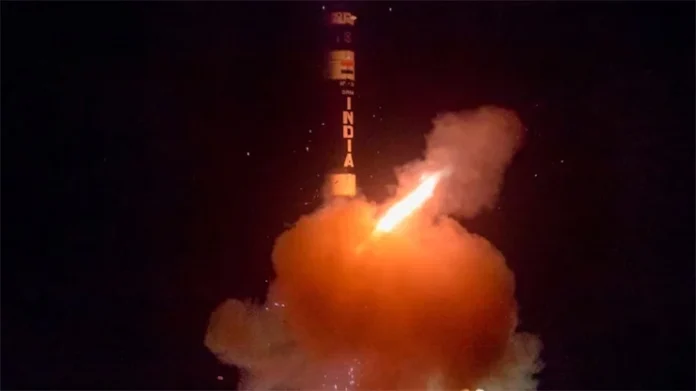New Delhi: The new-generation ballistic missile ‘Agni Prime’ was successfully flight-tested from an island off the Odisha coast on June 7 (Wednesday). Conducted from the Dr APJ Abdul Kalam Island by the Defence Research and Development Organisation (DRDO), all objectives of the test were successfully met. This was the first pre-induction night launch conducted after three successful developmental trials of the missile, validating the accuracy and reliability of the system, said the official statement issued by Ministry of Defence (MoD).
Range instrumentation such as radar, telemetry and electro-optical tracking systems were deployed at different locations, including two down-range ships, to capture flight data covering its entire trajectory, they added. The flight test set the path for the system’s inclusion into the Indian Armed Forces.
Senior officials of DRDO and Strategic Forces Command witnessed the successful flight test. Defence Minister Rajnath Singh congratulated DRDO and the armed forces for the success.
The test demonstrates that Agni Prime is prepared for an anti-ship mission and also has an increased quick response and accuracy. This is expected to significantly strengthen the precision strike capability of the Indian armed forces. The missile has the capability of hitting strategic targets with a nuclear payload as well as tactical targets with a conventional warhead. When used in either a tactical or strategic capacity, an Agni Prime with a payload of between 1.5 and 3 tonnes is capable of causing tremendous damage.
Agni Prime (Agni P) is a medium-range ground-based ballistic missile capable of carrying a nuclear warhead. It is a two-stage, surface-to-ground, solid-propellant missile with a range of up to 2,000 kms. Currently, India has in its arsenal ballistic missiles: “Agni-I” with a range of 700 kms, “Agni-II” with a range of 2,000 kms, “Agni-III” and “Agni-IV” with a range between 2,500 and 3,500 kms and “Agni-V” with a range that is larger than 5,000 kms. It is common knowledge that the Agni-VI missile, which can be launched from a submerged platform and has a range of up to ten thousand kilometres, is also in the process of being created.
The Agni Prime missile is the successor to the Agni-I and Agni-II missiles that are now on operational duty with the Strategic Forces Command. It has substantial upgrades, such as an improved composite motor casing, a manoeuvrable re-entry vehicle (MaRV), and improved propellants, navigation, and guidance systems. In the beginning, it was known as Agni-1P, and it was said that it had two stages that utilised the more recent technologies from Agni-IV and Agni-V in order to improve its precision and reliability.
The Agni-P’s MaRV enables the missile to deliver the warheads to two different places. The missile is kept secure inside a tandem dual canister launcher that has been hermetically sealed, and it is transported via road and rail. It employs a system for cold launch and has the ability to fire in salvo mode. For the final portion of the flight, the MaRV is equipped with four delta fins so that it can successfully dodge the missile defence system. It is a new type of missile that is part of the Agni Series, and it weighs only one-third as much as Agni-III. The Agni-V project perfected the use of composite materials, and those materials are being put to use in both the first and second stages of the Agni-P missile. This allows for significant weight savings. India has developed the Agni V missile as a means of reaching the economically developed East Coast of China as well as major cities in China, such as Beijing or Shanghai. The Agni V missile has also finished its night launch criteria in preparation for commencing serial production and deployment.
It is anticipated that the DRDO will use this missile as the basis for the development of a “carrier killer.” In addition, the Indian Ministry of Defence has already issued the directives necessary to replace the Prithvi series of missiles with an indigenous short-range ballistic surface-to-surface (SRBM) missile called Pralay. This conventional weapon has a range of between 150 and 500 kms. One of the goals of its development is to obtain maximum manoeuvrability against missile defence systems while also achieving improved accuracy for precision strikes.





